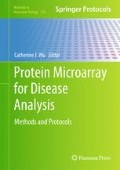Abstract
We here describe a new and cost-effective method for the high-throughput detection of protein–protein interactions in mammalian cells that combines the advantages of mammalian two-hybrid systems with those of microarrays. Nanoliters of samples containing mixtures of bait and prey expression plasmids together with an autofluorescent reporter are immobilized on glass slides in defined array formats and air-dried. Subsequently, monolayers of adherent mammalian cells are grown on these slides so that only cell clusters on top of each feature become transfected, whereas the surrounding cells remain untransfected. If the expressed proteins show any interaction, the bait and prey proteins inside the cells are functionally linked together at the promoter of the autofluorescent reporter, reconstituting transcriptional activity, and cells become fluorescent. The cluster of cells that express that particular combination of bait and prey constructs can be identified by its position in the array by simple fluorescence detection using common DNA array scanners or high-throughput microscopy. CAPPIA allows the quantitative detection of specific protein interactions in different types of mammalian cells and under the influence of different compounds. The high number of preys that can be tested per slide together with the flexibility to interrogate any bait of interest and the small amounts of reagents that are required makes this assay currently one of the most economical high-throughput detection assays for protein–protein interactions in mammalian cells.
Access this chapter
Tax calculation will be finalised at checkout
Purchases are for personal use only
References
Stelzl U, Worm U, Lalowski M, Haenig C, Brembeck FH, Goehler H, Stroedicke M, Zenkner M, Schoenherr A, Koeppen S et al (2005) A human protein-protein interaction network: a resource for annotating the proteome. Cell 122:957–968
Luo Y, Batalao A, Zhou H, Zhu L (1997) Mammalian two-hybrid system: a complementary approach to the yeast two-hybrid system. Biotechniques 22:350–352
Leonhardt SA, Altmann M, Edwards DP (1998) Agonist and antagonists induce homodimerization and mixed ligand heterodimerization of human progesterone receptors in vivo by a mammalian two-hybrid assay. Mol Endocrinol 12:1914–1930
Fields S, Song O (1989) A novel genetic system to detect protein-protein interactions. Nature 340:245–246
Uetz P (2002) Two-hybrid arrays. Curr Opin Chem Biol 6:57–62
Drees BL (1999) Progress and variations in two-hybrid and three-hybrid technologies. Curr Opin Chem Biol 3:64–70
Dang CV, Barrett J, Villa-Garcia M, Resar LM, Kato GJ, Fearon ER (1991) Intracellular leucine zipper interactions suggest c-Myc hetero-oligomerization. Mol Cell Biol 11:954–962
Shioda T, Andriole S, Yahata T, Isselbacher KJ (2000) A green fluorescent protein-reporter mammalian two-hybrid system with extrachromosomal maintenance of a prey expression plasmid: application to interaction screening. Proc Natl Acad Sci U S A 97:5220–5224
Ziauddin J, Sabatini DM (2001) Microarrays of cells expressing defined cDNAs. Nature 411:107–110
Suzuki H, Fukunishi Y, Kagawa I, Saito R, Oda H, Endo T, Kondo S, Bono H, Okazaki Y, Hayashizaki Y (2001) Protein-protein interaction panel using mouse full-length cDNAs. Genome Res 11:1758–1765
Fiebitz A, Nyarsik L, Haendler B, Hu YH, Wagner F, Thamm S, Lehrach H, Janitz M, Vanhecke D (2008) High-throughput mammalian two-hybrid screening for protein-protein interactions using transfected cell arrays. BMC Genomics 9:68
Mannherz O, Mertens D, Hahn M, Lichter P (2006) Functional screening for proapoptotic genes by reverse transfection cell array technology. Genomics 87:665–672
Eyckerman S, Verhee A, der Heyden JV, Lemmens I, Ostade XV, Vandekerckhove J, Tavernier J (2001) Design and application of a cytokine-receptor-based interaction trap. Nat Cell Biol 3:1114–1119
Author information
Authors and Affiliations
Corresponding author
Editor information
Editors and Affiliations
Rights and permissions
Copyright information
© 2011 Springer Science+Business Media, LLC
About this protocol
Cite this protocol
Fiebitz, A., Vanhecke, D. (2011). High-Throughput Mammalian Two-Hybrid Screening for Protein–Protein Interactions Using Transfected Cell Arrays (CAPPIA). In: Wu, C. (eds) Protein Microarray for Disease Analysis. Methods in Molecular Biology, vol 723. Humana Press. https://doi.org/10.1007/978-1-61779-043-0_11
Download citation
DOI: https://doi.org/10.1007/978-1-61779-043-0_11
Published:
Publisher Name: Humana Press
Print ISBN: 978-1-61779-042-3
Online ISBN: 978-1-61779-043-0
eBook Packages: Springer Protocols

